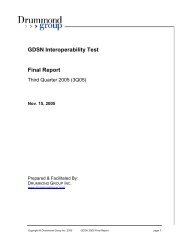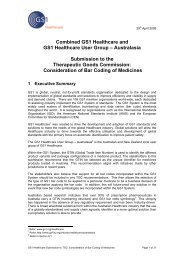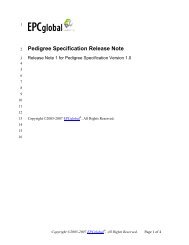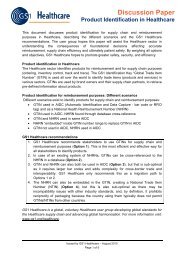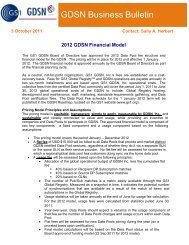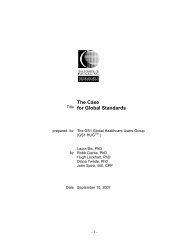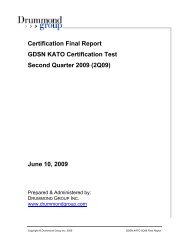SBDH Technical Implementation Guide - GS1
SBDH Technical Implementation Guide - GS1
SBDH Technical Implementation Guide - GS1
You also want an ePaper? Increase the reach of your titles
YUMPU automatically turns print PDFs into web optimized ePapers that Google loves.
Standard Business Document Header (<strong>SBDH</strong>) Version 1.3 - <strong>Technical</strong> <strong>Implementation</strong> <strong>Guide</strong><br />
1. Introduction<br />
1.1. Purpose<br />
This Standard Business Document Header (<strong>SBDH</strong>) <strong>Technical</strong> <strong>Implementation</strong> <strong>Guide</strong> clarifies the<br />
function, design and implementation considerations of the [<strong>SBDH</strong>]. The document can be used by<br />
technical implementers that need knowledge to implement the <strong>SBDH</strong> in their environment. It can also<br />
be used to educate others in the organization of the advantages of adopting the [<strong>SBDH</strong>].<br />
The Standard Business Document Header <strong>Technical</strong> <strong>Implementation</strong> <strong>Guide</strong> is to supplement [<strong>SBDH</strong>]<br />
so that the implementer understands not only the technical details but also practical ways to use the<br />
<strong>SBDH</strong> and guidelines on its appropriate use.<br />
This guide also demonstrates the benefits of one common document header that enables integration<br />
of documents between internal applications, enterprise applications, and business-to-business<br />
infrastructure by providing a consistent interface between applications. This consistent interface also<br />
enables any application to determine the logical routing requirements and/or the logical processing<br />
requirements of a document based on the information contained in the <strong>SBDH</strong>.<br />
Other benefits include the ability to:<br />
■ Leverage one common <strong>SBDH</strong> across all vendors, providing vendors with a common standard<br />
for integration development<br />
■ Leverage one common <strong>SBDH</strong> for any standard or file structure, such as EDI, XML or<br />
proprietary file structures<br />
■ Easily identify business documents without searching the business document for identifying<br />
information<br />
■ Route data through multiple applications using the information in the <strong>SBDH</strong><br />
■ Identify the automated process required for a specific business document<br />
■ Save parsing time and effort<br />
■ Maintain the association of the document and its originator for business and legal reasons<br />
■ Eliminate the different proprietary approaches that have been developed to route and process<br />
data<br />
1.2. Audience<br />
This document is intended to serve as an implementation guide for business and technical people who<br />
will implement GSMP XML standards using <strong>SBDH</strong>. Also, the implementation guide will be used by the<br />
following related <strong>GS1</strong> entities and user communities that have unique requirements for the usage of<br />
<strong>SBDH</strong> within their standards / business process;<br />
■<br />
■<br />
EPCGlobal<br />
GDSN<br />
1.3. Pre-requisite<br />
[<strong>SBDH</strong>] contains information about the usage of all elements of <strong>SBDH</strong>. This guide only covers those<br />
parts of the UN/CEFACT [<strong>SBDH</strong>] that are relevant to its implementation in the <strong>GS1</strong> world.<br />
As a pre-requisite it is expected that the user has read and understood [<strong>SBDH</strong>].<br />
July-2007, Issue 1 All contents copyright © <strong>GS1</strong> 2007 Page 4 of 21






